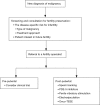Oncofertility in adult and pediatric populations: options and barriers
- PMID: 32257863
- PMCID: PMC7108982
- DOI: 10.21037/tau.2019.09.27
Oncofertility in adult and pediatric populations: options and barriers
Abstract
Cancer and its treatments can affect fertility in a variety of ways, and recent advances in cancer detection and treatment have led to an increasing number of cancer survivors for whom future fertility is a primary concern. Oncofertility is the study of interactions between cancer, anti-cancer therapy, fertility, and reproductive health. Fertility preservation aims to optimize fertility potential before initiation of gonadotoxic therapies. Sperm cryopreservation from an ejaculated sample is the gold standard for adults and post-pubertal adolescents, though added maneuvers such as medical therapy, penile vibratory stimulation, and electroejaculation can be employed when appropriate. When all these approaches fail, testicular sperm extraction can be used to obtain and cryopreserve testicular sperm from the azoospermic patient. Fertility preservation in the pre-pubertal pediatric patient is still experimental, but recent scientific breakthroughs with use of spermatogonial stem cells and testicular tissue transplantation offer great promise for the future. While there may be several practical, cultural, religious, and other barriers to fertility preservation, the establishment of a dedicated fertility preservation team can help to overcome these obstacles and optimize the utilization of fertility preservation in cancer patients of all ages.
Keywords: Azoospermia; fertility preservation; oncofertility.
2020 Translational Andrology and Urology. All rights reserved.
Conflict of interest statement
Conflicts of Interest: The focused issue “Contemporary Issues and Controversies in Men’s Health” was commissioned by the editorial office without any funding or sponsorship. The authors have no conflicts of interest to declare.
Figures
Similar articles
-
Oncofertility in pediatric patients: current perspectives.Contemp Oncol (Pozn). 2022;26(3):165-173. doi: 10.5114/wo.2022.120362. Epub 2022 Oct 14. Contemp Oncol (Pozn). 2022. PMID: 36381665 Free PMC article. Review.
-
Fertility Preservation in Pubertal and Pre-Pubertal Boys with Cancer.Pediatr Endocrinol Rev. 2018 Mar;15(3):234-243. doi: 10.17458/per.vol15.2018.jhmg.fertilitypubertalboys. Pediatr Endocrinol Rev. 2018. PMID: 29493128
-
Fertility preservation in boys facing gonadotoxic cancer therapy.Nat Rev Urol. 2022 Feb;19(2):71-83. doi: 10.1038/s41585-021-00523-8. Epub 2021 Oct 19. Nat Rev Urol. 2022. PMID: 34667304 Review.
-
Fertility preservation in male patients with cancer.Best Pract Res Clin Obstet Gynaecol. 2019 Feb;55:59-66. doi: 10.1016/j.bpobgyn.2018.12.004. Epub 2018 Dec 20. Best Pract Res Clin Obstet Gynaecol. 2019. PMID: 30744950 Review.
-
The feasibility of fertility preservation in adolescents with Klinefelter syndrome.Hum Reprod. 2013 Jun;28(6):1468-79. doi: 10.1093/humrep/det084. Epub 2013 Mar 28. Hum Reprod. 2013. PMID: 23539613
Cited by
-
Filling the Gaps in Oncofertility Care by Addressing Challenges Faced by Patients and Providers.Cureus. 2023 Dec 9;15(12):e50219. doi: 10.7759/cureus.50219. eCollection 2023 Dec. Cureus. 2023. PMID: 38192954 Free PMC article. Review.
-
Oncofertility in pediatric patients: current perspectives.Contemp Oncol (Pozn). 2022;26(3):165-173. doi: 10.5114/wo.2022.120362. Epub 2022 Oct 14. Contemp Oncol (Pozn). 2022. PMID: 36381665 Free PMC article. Review.
-
A Multicomponent Telehealth Intervention to Improve Oncofertility Care Delivery Among Young Cancer Patients: A Pilot Study.J Adolesc Young Adult Oncol. 2023 Apr;12(2):241-249. doi: 10.1089/jayao.2021.0224. Epub 2022 May 27. J Adolesc Young Adult Oncol. 2023. PMID: 35639102 Free PMC article.
-
Fertility Preservation in Children and Adolescents during Oncological Treatment-A Review of Healthcare System Factors and Attitudes of Patients and Their Caregivers.Cancers (Basel). 2023 Sep 2;15(17):4393. doi: 10.3390/cancers15174393. Cancers (Basel). 2023. PMID: 37686669 Free PMC article. Review.
-
Oncofertility care and influencing factors among cancer patients of reproductive age from Saudi Arabia.Front Reprod Health. 2022 Nov 17;4:1014868. doi: 10.3389/frph.2022.1014868. eCollection 2022. Front Reprod Health. 2022. PMID: 36466012 Free PMC article.
References
Publication types
LinkOut - more resources
Full Text Sources

